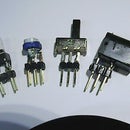Introduction: Analog Output - Convert PWM to Voltage
Arduino's and other microcontrollers provide analog to digital (ADC) conversion to convert an input voltage to a digital value. You might think that they also provide the converse which is digital to analog (DAC) conversion. This is not the case. Instead they provide pulse-width modulated (PWM) outputs (see second photo). The Arduino library provides this functionality with a function called analogWrite(). The name seems to imply DAC functionality, but it just controls the PWM output. For many applications, such as the case of motor control, PWM is sufficient. For other applications, such as creating a linear voltage or current driver, a real DAC is needed.
Creating a real DAC
Fortunately, it is easy to convert a PWM output to an analog voltage level, producing a true DAC. All that is needed is a simple low-pass filter made from a resistor and a ceramic capacitor. The simple RC low-pass filter shown in the third photo converts the PWM signal to a voltage proportional to the duty cycle. For the Arduino, an R value = 3.9K and a C value = 0.1uF works well for most applications.
For more details on this subject as well as calculating R & C values more suitable for your application, please consult this article.
Was this a useful electronics tip? If so, please cast your vote for it in the Electronics Tips & Tricks Contest.
How to vote: The voting button can be found at the top of this instructable. You can also visit the contest page and vote for other instructables as well. Multiple votes can be cast in each contest. If you see a tip you like, please show your gratitude with a vote.

Participated in the
Electronics Tips and Tricks













